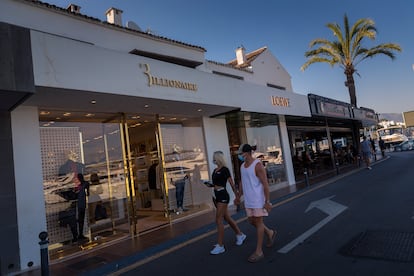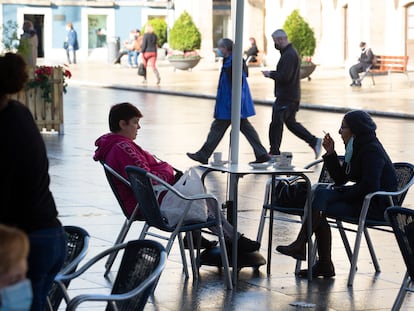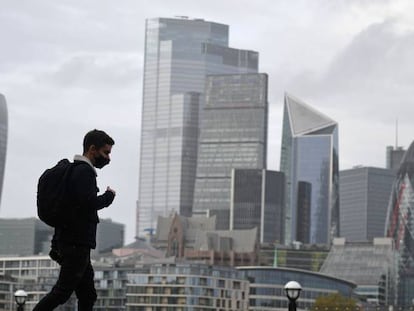The Spanish tourist sector closes its worst year since the 1970s
Fewer than 20 million foreign visitors have come to Spain in 2020 and revenues in the sector have plummeted by more than 75%, figures not seen in 50 years
The coronavirus crisis has devastated the tourism sector in Spain, creating a kind of volcanic fissure of considerable dimensions that oozes lava, destroying almost everything in its path. The figures speak for themselves, with revenues plunging by more than 75% and the year ending with fewer than 20 million foreign visitors, leaving behind collective spending of less than €20 billion compared to 83.5 million in 2019, spending almost €92 billion.
The collapse in demand is unprecedented. Unlike other sectors, there is little recovery in tourism as mobility between countries continues to be at a minimum. In fact, according to official records, it’s been half a century since so few foreign travelers came to Spain. In 1969, for example, almost 21.7 million foreign tourists visited the country while in 1968, there were around 19.2 million. In the best case scenario, 2020′s figures will fall somewhere between these two, although, according to the last data available released in October, Spain had 17.8 million foreign tourists, the same number as in 1967.
And that’s not the end of it. According to the Exceltur tourism lobby, revenue measured by the National Statistics Institute’s (INE) satellite account formula, which includes everything that tourism brings to the economy, will end the year at around €46 billion; that is, around €110 billion less than 2019 and a figure comparable with 1995, when the INE began to keep records. Even then, the comparison is misleading as it fails to take into account inflation; the fact that €46 billion is worth far less now than it was 25 years ago.
“Our country’s tourism is facing the worst crisis in its entire history,” Industry, Trade and Tourism Minister Reyes Maroto tells EL PAÍS. “And this is because the two elements that define the very essence of travel are affected: mobility and confidence.” The impact of the coronavirus has been the same everywhere. In fact, Spain’s losses are in line with what the World Tourism Organization (UNWTO) has estimated for countries across the board. According to the UNWTO’s last report, “tourism has dropped back to 1990 levels with arrivals falling by more than 70%.”
If tourism manages a quick bounce back to pre-pandemic levels, the impact may be short-lived but, as it stands, its share of GDP will drop from 12.4% in 2019 to just over 4% this year. “Of all the sectors, ours has been by far the hardest hit in the Spanish economy,” says José Luis Zoreda, vice-president of Exceltur. “If we don’t receive significant financial aid, thousands of companies and hundreds of thousands of jobs will be lost.” The productive fabric of the sector has been steadily unpicked since mid-March. At first, it was hoped that some of the summer could be salvaged. But the recovery was so slight that many businesses had to shut up shop once more – initially as a temporary measure but increasingly as a definitive one.
Uncertain future
There is a general consensus within the sector that the central government needs to offer a lifeline to a sector that kept the economy going during the last crisis. “It is time for the government to help companies survive,” says Oriol Anguera-Torrell, professor and researcher of Applied Economics in Tourism at the University of Barcelona. “And it must be done region by region, because the impact varies greatly in each.”
At least in the short-term, the future looks bleak. Not only is there the uncertainty triggered by the pandemic, there are other issues, including Brexit, the reduction in buying power and, among the better off, a considerable increased tendency to save, all of which amount to depressed demand that could take some time to recover. “There will be reduced mobility regarding big distances over the next two years,” says Juan Ignacio Pulido, director of the Laboratory of Tourism Analysis and Innovation at the University of Jaén.
This view is backed by the Funcas think-tank. “We expect a recovery of 40% in 2021 and 80% in 2022, according to what we are seeing in other countries,” Raymond Torres, director of the foundation’s international analysis department said several weeks back. “The figures will continue to be way below what they are in normal years, but there will be a powerful recovery because we are now at a minimum.”
Meanwhile, the government is somewhat more optimistic and has set a date for reactivating the sector, in light of the vaccination program. “We have our sights set on Easter 2021,” says Maroto. “That is when we hope to kickstart the sector’s recovery, which will begin with domestic tourism and, gradually, incorporate tourists from distant markets beginning with our European neighbors.”
Zero tourists, zero nightlife
Lucía Bohórquez, Palma
The tourism sector in the Balearic Islands was blindsided by the pandemic just as it was beginning to warm up for what was expected to be a bumper season. The total loss of revenue due to the lockdown at Easter did not bode well, although the gradual opening of the country in May with other sectors resuming activity seemed cause for a degree of optimism. On June 15, the first international tourists arrived in Mallorca from Germany and the sector started to navigate its way through the uncertainty, with hotels only partially open.

By mid-August, everything started to go wrong again. The biggest blow was dealt by the UK, the second-largest foreign market in the Balearic Islands, when it announced it was imposing a quarantine on travellers returning from Spain. The measure led to a flood of establishments shutting their doors and brought the end of the summer season forward to September. According to Exceltur, by the end of 2020, the Balearics will have had 82% less activity than usual. “There has been no help from the authorities in the way of reducing taxes for companies in the sector,” says María Frontera, president of the Hotel Federation of Mallorca.
The coronavirus has also devastated nightlife, one of the mainstays of the tourism industry in the region. In fact, there has been no nightlife since March as clubs and bars were unable to open even partially during the summer. The Balearic Association of Nightlife estimates that 63% of establishments will end up closing over the course of next year. “There are almost 400 workers in a very complicated situation, who usually live on their summer earnings in the winter,” said the president of the association, Jesús Sánchez, during a protest in front of an employment office.
“There were no customers so we closed”
Nacho Sánchez, Málaga
José Ravira still remembers when he opened a small kiosk on Venus beach, next to Marbella’s old town in 1969. Those were the days when tourism was a family affair; simpler times. He was around 20 years old and what he didn’t know was he was embarking on a life in the hospitality sector. Since then, he’s seen it all, from the “incredible” transformation of Marbella, the jet set years, the ETA terrorist attacks, the era of the controversial Marbella mayor, Jesús Gil y Gil, and the Arab petrodollars in Puerto Banús. “But I never imagined anything like what has happened this year,” he says. His specialty is a fish dish called pescados espetados, but he has only been able to serve this for three months as opposed to the usual 10, from March to December. In a normal year, he would now be in the final stretch of his season, but this year it ended in September. “There were no customers so we closed,” says Ravira, who now runs the famous Pepes Bar and feels uncertain about its prospects in 2021.

Ravira is not an exception along the Costa del Sol. Beach tourism has suffered the biggest setback in its history. Borders were closed, people were warned against traveling to Spain and restrictive measures were reintroduced during the second wave of the virus. “It’s a drama,” says Margarita del Cid, CEO of Costa del Sol Tourism, who criticizes a lack of information about the measures the central government has been taking. “Working with uncertainty is very negative,” she insists.
Currently, the vast majority of hotels are closed and have no idea when they will be able to re-open. The images of empty sun loungers and deserted promenades spell disaster. According to Costa del Sol Tourism, the 26 million nights booked in 2019 shrunk to seven million in 2020. The number of travelers has also fallen by more than 70%. And it remains to be seen how the crisis will affect the tourism industry in this part of Spain in 2021: “Part of the sector will be left by the wayside,” says Del Cid, who remains optimistic in spite of everything. “I am convinced that from the second half of next year everything will be better..
Zero urban tourism
Josep Catà, Barcelona
The situation is equally disastrous in Catalonia. One of the cornerstones of the region’s economy, the tourism sector is ending the year with a Christmas of restrictions, making it one of its worst in living memory. With the latest data available from the Catalan Statistics Institute released in October, the drop in foreign tourism has been 78.5%. Spending has fallen by 81.8% and overnight stays in hotels were more than 76.5% lower than the same period last year.

Between hotels, campsites and apartments, Catalonia has the capacity to accommodate 700,000 tourists. Now coastal towns that live almost exclusively from the sector, such as Lloret de Mar or Salou, are enclaves of closed establishments and thousands of unemployed workers. The situation is mirrored in urban destinations, such as Barcelona, where the sector has nose-dived. “It has been a horrible year,” says Manel Casals, director of the Barcelona Hotel Guild. “It began in January, which is never good, followed by February, which was marked by the cancellation of the Mobile [World Congress trade fair], and has continued with the restrictions due to the pandemic. We estimate that the sector will not start to recover until the middle or end of next spring.”
Currently there are 110 hotels open in the city, which is 25% of the 440 establishments that exist, and the occupation of those in operation does not exceed 15%. “The only visitors are the ones who have to come here, either for work or for the hospital,” says Casals. “The restrictive measures have a massive impact on us and we have no help.” Barcelona’s hotel sector estimates it has lost €1.4 billion this year, 82% of the revenue of previous years.
Lost high season
Guillermo Vega, Las Palmas de Gran Canaria
Tourism in the Canary Islands has also experienced the worst year in living memory, with two months of no tourists at all, hotels closed, businesses shut down and visitor figures more typical of the Franco era. Local businesses harbored hopes that the fall would bring better times, but the second wave of the pandemic shattered these hopes. With the high season considered a washout, hopes are now being pinned on the second quarter of 2021.
“We are in a situation where there are restrictions in all the issuing countries,” says the president of the Las Palmas Federation of Hotel and Tourism, José María Mañaricua who is among those already looking forward to next summer. “The Spanish government’s stipulation that PCR tests should replace antigen tests makes the destination more expensive and leaves us in a fragile situation.”
This view is reiterated by the President of the Canary Islands Confederation of Businesses, Agustín Manrique de Lara, who says, “There has been little loyalty shown by the central government to the Canary Islands.”
Until the resurgence of the virus in Europe, official figures predicted just over four million tourists by the end of the year, although government sources now accept that figure is unlikely to be reached. According to the INE, 3.4 million international visitors entered the Canary Islands between January and October, compared to more than 13 million the previous year. On a more optimistic note, the Canary Islands’ Minister of Tourism, Industry and Commerce, Yaiza Castilla, says “demand is still strong, but tourists cannot come” due to the restrictions put in place by the 14 main issuing markets. However, she is confident that at the beginning of next year the situation could be alleviated by the vaccine roll out. “We expect to welcome at least eight million tourists in 2021, although these forecasts change by the week,” she says.


